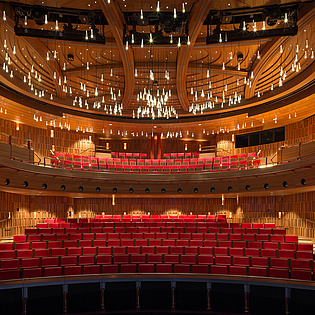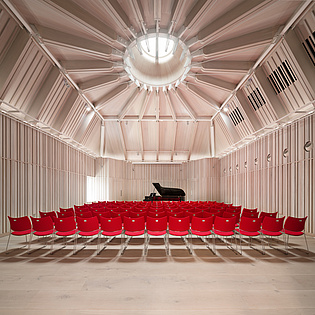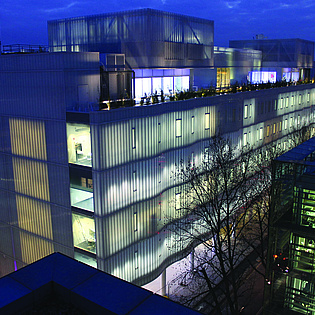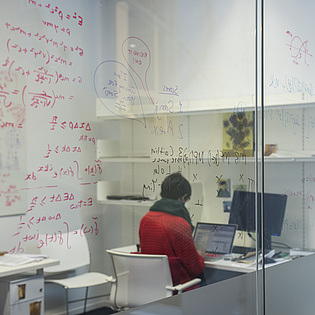"Architecture has two distinct phases:
the mental dream and reality's nightmare"
Ian Ritchie (IR) in conversation with Petra Eckhard (GAM)
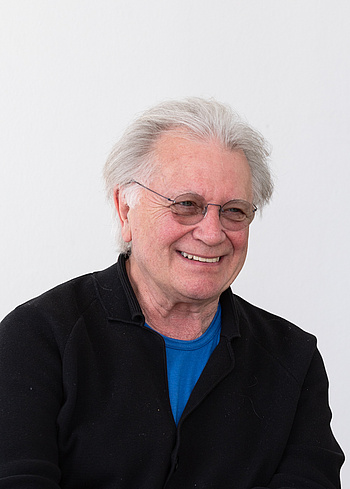
Ian Ritchie’s architectural programs emerge from the ethos to deliver socially beneficial and ecologically sustainable projects. His London-based office, Ian Ritchie Architects, has won more than 80 national and international awards, several of which the office received in 2018. Early this year, one of his latest projects, the opera house for The Royal Academy of Music in London, opened its doors and presented its new performance spaces for opera and musical theatre to the public. Petra Eckhard (GAM) met Ian Ritchie (IR) during his visit to Graz and talked to him about fluid dynamics and the power of poetry in the design process.
GAM: Can you describe your design philosophy in three words?
IR: “Sensual, intelligent, egoless.”
And also: “Aphorisms grow shoots.” Meaning, aphorisms set the design process going. The aphorism expressed by this particular phrase is especially important because it summarises my philosophy.
GAM: Can you elaborate on that? Why is an aphorism, or more generally, poetic language a useful tool for architectural design?
IR: Words come before the drawing during my design process, because exploring ideas through words doesn’t lock down a concept too quickly. When you draw something and it locks into your brain, you can’t actually delete it—even if you can burn the paper or throw it away—whereas using words one can explore ideas like an archaeologist. You’re looking for the essence of the project, so you’ve got this temporal palimpsest, if you like, in your brain about the way the project might appear in the next five years. And you go through the layers and shuffle aspects of the nascent design around—the client or the site or the environment or the politics or the social responsibility—all these things come into your mind, and it’s impossible to draw something. It’s actually stupid, in my opinion, to draw something too quickly. I suppose if you like language—written language or spoken language—it’s because language is something we have in common and it’s our natural means of communication, the one that we’ve evolved. Everybody more or less understands talking to each other and having conversation, though I do sometimes question the ability of today’s younger society to stay focused on a discussion or an argument. That seems to have vaporised. But, in my case, I carry on moving the words around until I find what I think is the key to the project, and then I condense that prose into a poem just to get the beginnings of a feeling of what the project might become. If I am very lucky, I write an aphorism, but the aphorism is rarely related specifically to a visualisation of the project. It’s often more about humour. In a way, it’s kind of designing with language.
GAM: So prior to designing a structure, it helps to compose a poem?
IR: Half-way through the competition for the UCL Neuroscience Lab I wrote a poem. I have to find it on my phone. This is from 2008/2009 and it is called “Dreaming of a Project,” because we actually wanted to win it. I can read it to you, if you want.
GAM: “Designing with the mind in mind” sounds beautiful, as does your use of contrasts in the poem: mental dream/reality’s nightmare, sun/clouds, mental/physical, etc. How do you see these metaphors playing out in your design philosophy?
IR: I think it is about living an ambiguous life. That is, if you’re sensitive to social issues and environmental issues, you can get quite depressed quite quickly. At the same time, if you lose a sense of optimism and, in a way, a child’s view of the earth, you won’t find any answers. We’ve got orbiting junk up there and there are programs to try and clean it up. It’s not going to be easy, in the same way that microplastics in the ocean are like a fog. People think that it’s a big pile of plastic sitting in some gyre in the Pacific, but it’s not—it’s a fog throughout all the oceans now. Two and a half years ago I was on a Russian research vessel in the Arctic. The impact of not seeing any plastic was reassuring. Then I got a phone call from a friend last year who was doing the same trip from west to east, and they had come across the plastic pollution. That’s a major issue, in the sense that we don’t know what the microplastic fog in the ocean will do to life in the ocean - but it can’t be beneficial! If you look at our planet as a giant computer, we (human beings) are a really nasty computer virus! Until we recognise that we are actually a virus, and not beneficial to the planet, we won’t change. So, the idea of going into space to colonise strikes me as completely and utterly daft.
GAM: What is your strategy to avoid reality’s nightmare?
IR: An interesting exercise is telling a story of a tree to architecture students: If you describe all the aspects of a tree you realise you are looking at a miracle. Unbelievable. Genetically a tree species may be the same, but each individual tree is different. Everything is intelligent: the tree knows how to put out branches to capture the maximum sunlight. It’s driven by the invisible, the moon’s pull, gravity, O2 and CO2 and of course light. This kind of wonder is a metaphor for the proper way of designing. If design is a process, not an end product, the future lies in our ability to grow architecture in a way that is intelligent. It may still have to do with algorithms but it has a lot more to do with the materiality of how we make things.
At the moment, when we look at the building industry, it produces 50% of the carbon in the atmosphere, and apparently 10% of that total is produced by concrete. There are ways of manufacturing concrete that is not as carbon-intensive, but we are not addressing those issues—such as how can we make buildings without digging great big holes in the ground to pour concrete into, or long piles. There are ways of looking at slightly more dynamic buildings that don’t damage the earth and its surface, and that can be stable without having to be super stiff (static). I work with “dynamics”, because that’s how I learned engineering: all structures move, so instead of looking at trying to be absolutely rigid you can look at things that are more flexible, but are safe. That’s how a tree works, interestingly. You bend with the wind a little bit, but obviously our own internal dynamic and our sense of balance have to measure against that. But we spend a lot of energy doing things that are too extreme instead of relaxing and saying,'it’s fine.'
GAM: Ethical is a key term that one often reads in connection with your designs. You also use it in your mission statement. What does it mean to you?
IR: It’s about sharing values, which could also describe my design philosophy. Today, we seem to value shares more than we share values. These values are the ones that have ethics behind them, whether it’s working with other people, interpersonal relationships, working with the Earth, the planet, oxygen: it’s a way of finding an intelligent way of working with situations. Nature is unpredictable whereas we spend our time designing predictability, taking away unpredictability. We have to predict the behaviour of a structure, predict the behaviour of air moving in a building, and predict the first and second reflections you’ll get off a building with light or sound. But in doing so we are always designing out the beauty, with every step we take toward predictability.. Therefore, we must invent an aesthetic that suits our age in order to be able to say “this is beautiful.”
Beauty is simply non-linear. It’s why we like watching a flame, or light on the water on a sea or a river: because you cannot predict the next thing. And that’s the beauty of nature. We will probably have the computing power in the next hundred years or so to measure every single snowflake that falls out of the sky somewhere on the planet, but there is no point so we won’t. That magic of nature—the unpredictable—is beauty. When we say “beauty is in the eye of the beholder” this only refers to the man-made.
GAM: Your architectural designs are also quite unpredictable. Your designs cannot be pinned down to a distinctive style…
IR: We don’t have a style. You can’t say that’s an Ian Ritchie Architects building. You wouldn’t know, although you might begin to guess because of the refinement of everything and allusions to visual unpredictability through randomness of the behaviour of light or rocks, or planned ageing. People discover we did this building or that building, and that’s kind of nice. Intellectually we’ve been always outsiders. I never received an overall critical review of our work.
And you can’t get out of bed every morning thinking, 'I am doing another one of those buildings.' I would die a death of boredom.
GAM: Is this partly due to the fact that you take context analysis or the individual clients’ ideas very seriously?
IR: To give you a quite early example: The first building I did in England was called “Eagle Rock,” a house which looks a little like a crashed airplane in a wood. Peter Cook came down to see and review it and said: “Oh god, the eagle has landed.” He never expected to see a house like that in England. Possibly California, yes, but not in England. But it was the result of a conversation I had with the client three years earlier, while I was renovating the outside of her large villa in Italy. Her passion was orchids, and she would go on trips looking for rare orchids. She mentioned, three years before she did return to England, that she would like a house, and asked me “what would my house be like?” I replied that given her description of her life she just needed a very good suitcase, and asked if she wanted to be encumbered by something anchored to the ground. Three years later we looked for and found a site. At that point the conversation from three years earlier, about the flying suitcases, became translated through a poem into the idea of packing cases in the landscape with a transparent canopy over top. It was the idea that nothing was anchored to the ground, that she could pick up the house and leave if she wanted to. Of course, as she was getting older, everything became serious. The concept evolved into the roof being glass and permanent, and the boxes being joined up to give her a house. That’s why it looks like a crashed airplane.
It all comes from starting with the user. Knowing if we understand the user and what they really want, that’s when we can become skilful architects. If we start the other way around—what’s it going to look like? —you never get to the user. We always start from the inside. It’s the fundamental thing: is the brief correct? You test it against the users. Often, it’s not what they want. It’s quite rare for scientists, or even musicians or students, to be involved in the process with the architect. You could argue that they are not going to be the ones who will be there, if the building is there for a hundred or two hundred years. However, they are there for that moment, and it’s up to us to understand what they really need and then to think beyond it. And when you do that, the spatial configurations that start to emerge have to be balanced by the context with the outdoor walls of your building, which become walls framing the public spaces of the city. Each street is a room in the city, and it has these walls, and very often architects forget that they are actually creating these framing elements that create a room in the city. All of that leads you to thinking, to analysing, as you would compose an opera. That’s a nice expression, as opera in Italian, of course, means 'a work'. So, I think that’s more demanding of an architect to think like that than it is to “render and tender.”
GAM: What was this process like when you designed the opera house for The Royal Academy of Music? How did the context analysis finally translate into architectural form?
IR: When we came to design the new opera house for the Royal Academy of Music, we started off studying Cremona musical instruments, such as those of Stradivarius and asked: Why were they so special? What was special about the wood, the forest, the way the trees grew, why some but not others; the varnish or how they [musicians] treated it? A rare preconception - we knew we were going to be using wood. Wood has a wonderful ability to reflect sound, depending on its density and is so alive - one wonders if it actually ever stops moving. I went out to find the best joinery company in Britain, because our office knew nothing about wood. The learning curve was fantastic. When you are designing an opera house it’s all about the voice. The voice is the basis of acoustics. When you start producing a sound with your voice, it comes through the many chambers of your body, it then passes through the vocal cords, through your mouth, your tongue and the final space is the one in which you can hear the sound. For me this auditorium was an extension of the body and I knew that wood is the material of that moment when sound emerges. At the opening night it was a relief, because the sound was sensational. So, we nailed it aesthetically and acoustically. Also, the aesthetic detail geometry of the recital hall and recording space on top of the opera house auditorium came from musical instruments, fairly literally, whether the bow or the tuning end of a violin or a cello. That gave us all the inspiration for designing it. So, the students now have two magical spatial instruments to play with.
GAM: Your office is based in London, a global city with a dense, eclectic center with high land prices. Which challenges do you face at the moment?
IR: I think the challenges with London are not its density per se. They are to do with homelessness. That comes from certain political directives, and the numbers of homeless have grown again. I was very surprised to see them on the streets of Graz; I thought Graz was wealthy enough to have the right policies. You can’t stop those who want to live on the street, but the people who end up on the streets due to housing policies I find deeply, deeply hurtful. I think it’s interesting that 90% of the people of this planet are sitting on the ground. Who invented the chair? The Persians. Why they invented it I don’t know, but it’s interesting that the majority of human beings still sit on the ground. When we see someone sitting on the ground in the West, we ask: “Why?” We’ve paved everything and we have invested money; why would you want to sit down there? You get a microcosm of capitalist society in London that’s in your face. It can be quite nasty. A decent society, I think, educates its people, houses its people and looks after them when they are not well or old. A tripod of a civilized society. When all of those become commodities, society is severely undermined: you’re creating an artificial one. Even if you like this form of society, it’s unnatural because it is being forced all the time because everything is for sale.
GAM: At the moment the economic impacts of Brexit are a major area of debate. What do you think would be the effects of Brexit on architectural production in the UK?
IR: All I can comment on is that you have already an attitude, amongst many architects, that could be best summed up as: “I want to do a building on every continent.” That strikes me as a very strange ambition. “I am a global architect, because I’ve done it.” If you ask those architects: “How would you adapt to the culture? Would you adapt to the culture?” They wouldn’t know how to reply, because the only way they can do these buildings is through wealthy clients who want to get value out of the project. The brief is affected by needing to extract value, as that value is attained through iconic shape, by putting up more apartments in the tower than anybody else could. So that’s the way it works.
As for Brexit, it’s a sign of insanity. When the EU was set up initially as a common market and as an economic model in 1950s, it created the opportunity to open doors between countries. I thought it was a stepping stone to a more open world, and that Europe with its initial six EU member countries would actually be an extraordinary model for the rest of the world to look at. We all have cultural differences and have been at war with each other for centuries, but somehow, we managed to be intelligent and create cultural exchanges, Erasmus programs—all these things came from the idea of a united Europe, and it doesn’t mean it has to be one homogenous country. If Brittany fell into the Atlantic Ocean, Europe would be a poorer place. You don’t want culture to disappear. The idea that you could bring all of this together as a model for the future of the planet was brilliant. To see the United Kingdom doing what it is doing now is not a United Kingdom decision, it’s an English decision. It’s got nothing to do with Scots. The Scots don’t attack Europe. When you see the risk of a disintegrating Europe, as a model, I get very sad, I have to say. In a way, I’m explaining that architecture is somewhere way down the list when it comes to Brexit.
GAM: You initially came from the world of medicine and then changed to architecture. Many people would consider this a big shift …
IR: In fact, it isn’t. Everything goes through our brains, as we are humans. Medicine is largely looking at the inside of your body, through our brain, and architecture looks at the body in space on the outside, through our brain. So, it’s not a huge jump. If you take your own hand, everything is architecture: you have got a skin, all the services, and you’ve got the structure underneath, and its dynamic is controlled by the brain. It moves. Those are the basic ingredients of architecture. Statics is the German engineers’ language, as is the concept of “nothing moves and everything is fixed.” Of course, nothing is fixed. Also, the brain is scale-free. This is why our UCL neuroscience building has all the scales of spaces that (users) want. Long ones, tall ones, small ones; and they also know they can change them, up to a certain point. It’s another scientific instrument for them.
GAM: With the UCL Institute of Cognitive Neuroscience project you designed a place for education and research. What is the most important skill students of architecture must acquire?
IR: I have noticed that, particularly since you now pay for your education in the UK and in America, tutors say: “Just do it. Come back tomorrow.” Actually, thinking is the most difficult thing to do. Students are not encouraged to think; they’re encouraged to do. In other words, they’re encouraged to be homo faber (the maker) rather than homo sapiens (the thinker). I think that is part of our disease. The other one, which I’ve learned, again from neuroscientists, is that our brains evolved not to understand the environment; they evolved to understand each other and to communicate with other human beings. Our natural DNA is not to read the environment, which is probably why we make mistakes in the air and make mistakes in the water. At the moment, because education is now a commodity—the production of a university is a commodity and everything is measured, quantified financially or by exam results—it’s not measured by quality anymore. How to learn to think is the thing that is missing. I don’t think students are encouraged when time comes into play. I’m quite interested by the student that carries on thinking, and if they haven’t the maturity yet to program their thinking time into their work, that’s understandable because they’re students. Learning to think and making the time to think is vital.
GAM: In your opinion, what makes a successful architectural project?
IR: My favourite architect of all time is Sinan. He was the architect to the Ottoman Empire. He became an architect at 50, and before that he was an engineer. One could say he was fortunate in that he had the richest client in the world for fifty years. Sinan was taken into the army in his twenties and had a natural ability to analyse problems and solve them, and he understood geometry from a young age. This included geology, water supply, drainage, boat building, engineering and organising teams to work together. Working together well where no individual is the owner of the work is the secret. There are wonderful examples of his work which have to do with the Ottoman Empire expanding to the West. In particular they had problems with bridges, and particularly with one bridge that kept collapsing. Many engineers were trying to solve it, and he looked at it and said: “We just widen the river to slow the water speed down.” It is all about the infrastructure. He understood that.
GAM: Thank you for the interview.

